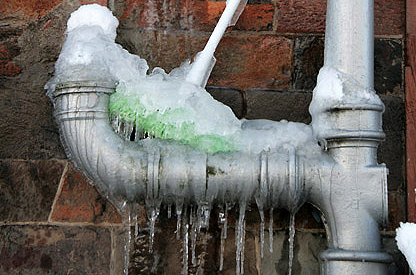Protecting Your Pipes from Cold Weather: Top Tips
Protecting Your Pipes from Cold Weather: Top Tips
Blog Article
In this article underneath you can get additional helpful resources regarding 6 Ways to Prevent Frozen Pipes.
:strip_icc()/snow-outdoor-faucet-pipes-4af65d1e5e904fb1aa7bf74071fe5d89.jpg)
Cold weather can damage your plumbing, especially by freezing pipelines. Right here's just how to avoid it from happening and what to do if it does.
Introduction
As temperature levels decline, the risk of frozen pipes boosts, possibly leading to costly repair services and water damage. Comprehending exactly how to stop icy pipelines is essential for property owners in chilly environments.
Comprehending Frozen Pipelines
What triggers pipes to ice up?
Pipelines freeze when exposed to temperatures listed below 32 ° F (0 ° C) for extended periods. As water inside the pipes freezes, it increases, taxing the pipeline wall surfaces and possibly creating them to break.
Threats and damages
Icy pipes can lead to water supply interruptions, home damage, and costly fixings. Burst pipes can flooding homes and create comprehensive architectural damages.
Indicators of Frozen Piping
Determining frozen pipelines early can avoid them from breaking.
Just how to identify frozen pipes
Seek lowered water circulation from faucets, unusual odors or noises from pipelines, and visible frost on exposed pipes.
Avoidance Tips
Insulating susceptible pipelines
Wrap pipelines in insulation sleeves or use heat tape to safeguard them from freezing temperatures. Focus on pipelines in unheated or exterior areas of the home.
Heating strategies
Maintain indoor areas effectively warmed, particularly locations with pipes. Open cupboard doors to allow cozy air to flow around pipes under sinks.
Protecting Outside Pipes
Garden hoses and outdoor taps
Disconnect and drain pipes garden hoses prior to winter. Mount frost-proof faucets or cover outside faucets with protected caps.
What to Do If Your Pipes Freeze
Immediate activities to take
If you suspect frozen pipes, maintain taps open to relieve pressure as the ice melts. Use a hairdryer or towels taken in hot water to thaw pipes slowly.
Long-Term Solutions
Structural changes
Take into consideration rerouting pipes far from exterior walls or unheated locations. Include extra insulation to attics, basements, and crawl spaces.
Upgrading insulation
Purchase premium insulation for pipelines, attics, and wall surfaces. Appropriate insulation helps preserve consistent temperature levels and decreases the threat of frozen pipelines.
Verdict
Avoiding frozen pipelines requires aggressive actions and quick actions. By understanding the causes, indicators, and safety nets, house owners can safeguard their pipes during cold weather.
6 Proven Ways to Prevent Frozen Pipes and Protect Your Home
Disconnect and Drain Garden Hoses
Before winter arrives, start by disconnecting your garden hoses and draining any remaining water. Close the shut-off valves that supply outdoor hose bibs and leave the outdoor faucet open to allow any residual water to drain. For extra protection, consider using faucet covers throughout the colder months. It’s also important to drain water from any sprinkler supply lines following the manufacturer’s directions.
Insulate Exposed Pipes
Insulating your pipes is an effective way to prevent freezing. Pipe insulation is readily available at home improvement stores and is relatively inexpensive. Pay close attention to pipes in unheated areas such as the attic, basement, crawl spaces, or garage. Apply foam insulation generously to create a buffer against the cold. You can also wrap your pipes in heat tape or thermostat-controlled heat cables for added warmth.
Seal Air Leaks
Inspect your home for any cracks or openings that could let in cold air. Seal any holes around the piping in interior or exterior walls, as well as the sill plates where your home rests on its foundation. Additionally, make sure to keep your garage door closed unless you’re entering or exiting. Leaving it open creates a significant air leak that can lead to frozen pipes.
Allow Warm Air Circulation
During cold snaps, it’s essential to allow warm air to circulate evenly throughout your home. Leave interior doors ajar to promote better airflow. Open kitchen and bathroom cabinets to help distribute heat consistently around the rooms. If you have small children or pets, be sure to remove any household chemicals or potentially harmful cleaners from open cabinets for safety.
Let Faucets Drip
A small trickle of water can make a big difference in preventing ice formation inside your pipes. When temperatures drop significantly, start a drip of water from all faucets served by exposed pipes. This continuous flow helps prevent the water from freezing. Additionally, running a few faucets slightly can relieve pressure inside the pipes, reducing the chances of a rupture if the water inside does freeze.
https://choateshvac.com/6-proven-ways-to-prevent-frozen-pipes-and-protect-your-home/

I ran across that entry on How to Prevent Your Pipes From Freezing while doing a search on the search engines. Sharing is good. You never know, you will be doing someone a favor. Thanks so much for going through it.
Schedule Now! Report this page